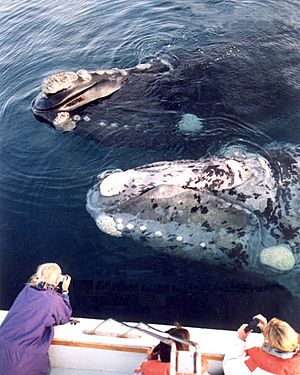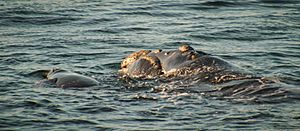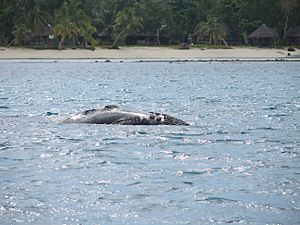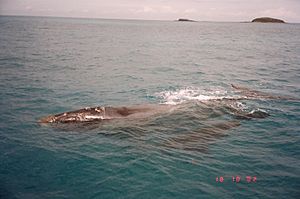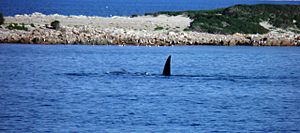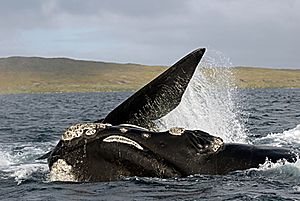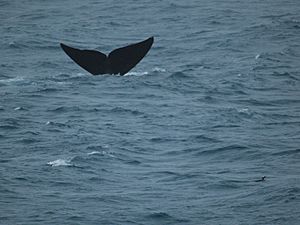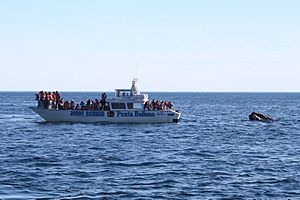Southern right whale facts for kids
Quick facts for kids Southern right whale |
|
|---|---|
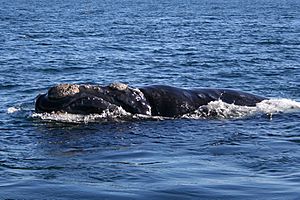 |
|
| Conservation status | |
| Scientific classification | |
| Genus: |
Eubalaena
|
| Species: |
australis
|
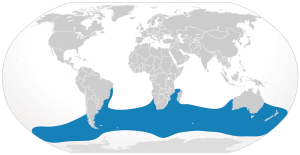 |
|
| Range | |
| Synonyms | |
|
|
The southern right whale (Eubalaena australis) is a type of baleen whale. It is one of three species known as right whales. These whales live in the genus Eubalaena.
About 10,000 southern right whales live across the southern part of the Southern Hemisphere.
Contents
- Discovering the Southern Right Whale Species
- Southern Right Whale Appearance
- Southern Right Whale Behavior
- Where Southern Right Whales Live
- Whaling History
- Protecting Southern Right Whales
- Whale Watching
- Images for kids
- See also
Discovering the Southern Right Whale Species
Scientists first grouped all right whales together in 1758. They thought all right whales, including the bowhead whale, were one species. For many years, scientists debated how to classify these whales. They often changed their minds about how many species there were.
In 1822, the southern right whale was first described as Balaena australis. Later, in 1864, scientists realized that bowhead whales and right whales were different. They created a new group, Eubalaena, for the right whales.
Scientists then noticed differences in the skulls of northern and southern right whales. This suggested there were at least two species: one in the Northern Hemisphere and one in the Southern Ocean.
DNA Evidence Confirms Species
In 2000, new studies using DNA samples helped solve the puzzle. Genetic evidence showed that northern and southern right whales had not bred together for millions of years. This proved that the southern right whale is its own distinct species.
The northern Pacific and Atlantic populations are also different. Interestingly, the North Pacific right whale is more closely related to the southern right whale than to the North Atlantic right whale.
Scientists believe that right whale groups first split when North and South America joined. Warmer temperatures near the equator then caused a second split. This created the northern and southern groups, stopping them from breeding with each other.
In 2002, the International Whaling Commission (IWC) agreed with these findings. They decided to keep the Eubalaena name for this group of whales.
Whale Family Tree
A cladogram is like a family tree for animals. It shows how different groups are related. The following diagram shows how the southern right whale fits into its family.
{{cladogram|title=Family Balaenidae |align=left |caption=The right whale family, Balaenidae |cladogram=
| Family Balaenidae |
|
||||||||||||||||||
Southern Right Whale Appearance
Southern right whales are easy to spot. They have rough patches called callosities on their heads. They also have a wide back with no dorsal fin. Their long, curved mouth starts above their eye.
Their skin is usually very dark grey or black. Sometimes, they have white patches on their belly. The callosities look white because of tiny creatures called cyamids, or whale lice, that live on them.
Southern right whales look very similar to the North Atlantic and North Pacific right whales. They only have small differences in their skull shape. They might have fewer callosities on their head than North Atlantic whales. They may have more on their lower lips than the two northern species. Scientists are not sure what the callosities are for. They might help protect the whales from predators.
Size and Weight
An adult female southern right whale is about 15 m (49 ft) long. She can weigh up to 47 tonnes (46 long tons; 52 short tons). Some larger whales have been recorded at 17.5–18 m (57–59 ft) long. These larger whales can weigh 80 tonnes (79 long tons; 88 short tons) or even up to 90 tonnes (89 long tons; 99 short tons). This makes them a bit smaller than other right whales in the Northern Hemisphere.
Right whales usually do not cross warm waters near the equator. They have thick layers of blubber (fat) that keep them warm. This blubber makes it hard for them to cool down in tropical waters. However, there have been a few rare sightings of these whales in warmer areas.
Some southern right whales have unusual colors. Some even stay white as they grow up. Scientists are not sure how long these whales live. Some whales seem to live for over 100 years.
Southern Right Whale Behavior
Southern right whales are very active on the water's surface. They are also curious about human boats. They seem to interact with people more than the northern right whale species.
One special behavior of southern right whales is called tail sailing. They use their raised tails to catch the wind. They can stay in the same spot for a long time. This seems to be a form of play. It is most often seen off the coasts of Argentina and South Africa. Other whales, like humpback whales, also do this.
Right whales often interact with other sea animals. They are seen with humpback whales and dolphins. There have even been reports of southern right whales and humpbacks possibly mating. This has been seen off Mozambique and Bahia, Brazil.
Migration and Family Life
Female southern right whales have strong connections to their birthplaces. They often return to the same areas to have their calves. They usually have a calf every three years. However, this can vary from two to 21 years. Different areas in the same region might be used for different reasons by the whales.
This species has also been known to nurse (feed milk to) baby whales that are not their own.
Where Southern Right Whales Live
Southern right whales spend their summers in the far Southern Ocean. They feed there, probably near Antarctica. They can also feed in cooler waters, like those near Buenos Aires.
In winter, they travel north to breed. You can see them along the coasts of many countries. These include Argentina, Australia, Brazil, Chile, Namibia, Mozambique, Peru, Tristan de Cunha, Uruguay, Madagascar, New Zealand and South Africa. Some whales also spend winter in sub-Antarctic regions.
The total number of southern right whales is about 10,000. Since hunting stopped, their population has grown by about 7% each year. The groups in South America, South Africa, and Australasia do not mix much. This is because mothers are very loyal to their feeding and calving spots. They also pass these choices on to their calves.
Historical Range
Whaling records show that these whales once lived in a much wider area. This included parts of the central northern Indian Ocean. If a recent sighting off Kiribati was truly a southern right whale, it means they can cross the Equator. This would mean their original home range was much larger and further north than it is today. There was also a report of a right whale stranded on the northwestern coast of India in 1944.
Calving grounds are usually in calm, sheltered waters. But some have been found near high-wave coastal areas. These are often close to land cliffs and deep waters. The sound of waves might help hide baby whales from predators. Deep areas near shallow spots might also be training grounds for calves. They can practice for their long migrations to feeding areas.
Population Numbers
In October 2008, National Geographic estimated the southern right whale population at 10,000. An earlier estimate in 1998 was about 7,000. Scientists used data from surveys in Argentina, South Africa, and Australia. They then estimated numbers for other areas, including males and calves.
It is thought that the population will only reach less than 50% of its original size by 2100. This is because whaling had a very big impact. Also, these whales recover slowly.
Natural predators can also affect where whales live. Many places in the Southern Hemisphere are named after southern right whales. This shows where they used to be found. Examples include Walvis Bay, Punta Ballena, and Right Whale Bay.
Southern Right Whales in Africa
South Africa
Hermanus in South Africa is famous for whale watching. From June to October, southern right whales come to the coastal waters of South Africa. Over 100 whales can be seen in the Hermanus area. They come to Walker Bay to have their calves and to mate. You can see many behaviors like breaching (jumping out of the water) and tail sailing. In False Bay, you can see whales from the shore from July to October. Plettenberg Bay and Algoa Bay also host southern right whales from July to December. You can watch them from land or from boats with special permits.
More whales are visiting the north-eastern part of South Africa, like Ballito. This shows that the whales are expanding their normal areas. They are returning to places where they used to live before whaling.
Western Africa
In Namibia, most whales are seen south of Luderitz. Only a few whales travel further north to old breeding grounds like Walvis Bay. Before whaling stopped, whales were rare along Namibia's shores. The first calving was confirmed there in the 1980s.
Historically, these whales might have lived further north. They could have reached Angola and Baia dos Tigres (Tiger Bay). There have been a few unconfirmed sightings in Gabon in recent years.
Eastern Africa
In Mozambique and Madagascar, southern right whales are becoming more common. However, their numbers are still very small. Historically, many whales were seen off Durban and in Delagoa/Maputo Bay. The first sighting off Mozambique since whaling ended was in 1997.
More whales seem to be traveling further north to calve. This includes places like Île Sainte-Marie and Antongil Bay in Madagascar. Whales were once hunted off Tanzania. They might still be seen there sometimes, for example, around Zanzibar.
Mid–South Atlantic
Illegal whaling by the USSR badly affected whale populations. This includes the whales off Tristan da Cunha and Gough Island. This means fewer whales visit these areas today.
Records show that right whales once reached as far north as the island of Saint Helena.
Southern Right Whales in South America
Brazil
In Brazil, over 300 individual whales have been identified. The State of Santa Catarina is a key area for breeding and calving whales from June to November. Females from this group also calve off Argentina and Uruguay.
Recently, fewer whales have been visiting the coasts. This might be due to human activities and conflicts with fishing. Sightings in other areas of Brazil are rare. However, whales have been seen entering the lagoon of Lagoa dos Patos.
Some whales travel further north to Bahia and Abrolhos Archipelago each year. Whaling records show that right whales used to travel further north than they do today.
Argentina
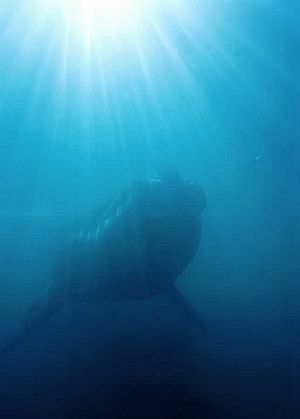
Many southern right whales have died at Península Valdés, Argentina. Between 2003 and 2011, 482 dead whales were found there. Most of these were young calves.
More whales are being seen in other places in Argentina. These include Golfo San Jorge and Tierra del Fuego.
Uruguay
In Uruguay, coastal areas like Punta del Este are gathering spots for whales during breeding seasons. However, they are not likely calving grounds. Uruguay has created a whale sanctuary off Latin America. This protected area was delayed for years by countries that supported whaling.
Chile and Peru
The whale population in Chile and Peru is very small, with fewer than 50 individuals. This group is at risk from increasing ship traffic and fishing. Scientists are working to protect them.
Calving has been confirmed in the Chiloé Archipelago. It is hoped that new tourism can start in the eastern Strait of Magellan. This is because more whales are being seen there.
Southern Right Whales in Oceania
Historically, whale populations in Oceania were very large. Early settlers even complained that the sounds of whales kept them awake at night. Studies show that whales in Australia and New Zealand interact. However, scientists are not sure how much.
Australia
Southern right whales in Australia are recovering well. Their numbers increased from 2,100 in 2008 to 3,500 in 2010. There are two main groups in Australia. The southwestern group has about 2,900 whales. The southeastern group is much smaller, with only dozens to 300 whales.
South Australia
You can find right whales in many parts of southern Australia. The largest group is at the Head of the Bight in South Australia. Over 100 whales are seen there every year from June to October. Visitors can watch them from boardwalks or by taking a scenic flight.
Another place to see whales is Encounter Bay. Here, whales can be seen close to the beaches of the Fleurieu Peninsula. A newer nursery area is near Eyre Peninsula, especially at Fowlers Bay. The South Australian Whale Centre has information about whales and whaling history.
Victoria
Fewer whales are seen in Victoria. The only regular breeding ground is at Warrnambool. However, whale sightings are slowly increasing in other areas of Victoria. These include Port Phillip Bay and Apollo Bay. Tasmania is also seeing more whales in recent years.
Other states and territories
Whales used to live off the coasts of Western Australia, New South Wales, and Queensland. The east-coast population is still very small. However, numbers are increasing in many areas. These include Port Jackson and Jervis Bay.
Whale numbers in sub-Antarctic regions vary. They are recovering well at the New Zealand Subantarctic Islands. But they are recovering slower at Macquarie Island.
New Zealand
Scientists are still learning about right whale populations in New Zealand. Before whaling, there could have been 28,800 to 47,100 whales. About 35,000 to 41,000 were caught between 1827 and 1980. The number of whales that survived might have been as low as 30.
No sightings were recorded on the main islands between 1928 and 1963. Full recovery is expected to take about 60 years. If illegal hunts by the Soviet Union had not happened, the New Zealand population could be much larger. This population also has very low genetic diversity. This is a concern for their future.
Most right whales gather at Auckland Islands and Campbell Islands. Up to 200 whales may spend winter in Port Ross. This small area is used for feeding, breeding, and calving. The low genetic diversity has also caused changes in skin colors in this group.
Scientists used to think there was a very small group of whales on New Zealand's main islands. In winter, whales travel north to New Zealand waters. Large groups sometimes visit the southern coasts of South Island. Bay areas along Foveaux Strait are important breeding spots. Calving is seen all around the nation. It is more common around North Island shores.
Some areas that once had many whales now have fewer sightings. These include the Marlborough Region and Golden Bay. Very little is known about modern migrations to the Kermadec Islands and Chatham Islands.
Recent studies show that whales from New Zealand's main islands and the sub-Antarctic islands interbreed. However, it is not known if they came from one original population.
Other Locations
Little is known about southern right whales in other oceanic islands. Historically, whales were found in lower latitude areas. This included Pacific Islands like the Gilbert Islands (now Kiribati). They also visited the central Indian Ocean.
Populations around sub-Antarctic islands in the Scotia Sea were badly damaged. These include South Georgia and the South Sandwich Islands and Falkland Islands. Their recovery is slow. Whale sightings around Antarctica are also rare.
Indian Ocean
Historically, whale populations lived around the Crozet Islands and Kerguelen Islands. They also migrated to La Roche Godon and Île Saint-Paul. These groups might have been different from whales seen on Mozambique coasts. Recovery in these Indian Ocean areas is likely very slow. Few sightings have been reported recently.
Whales were hunted in the central Indian Ocean near the equator. This area was between Diego Garcia and the Cocos (Keeling) Islands. This range is similar to other populations around Latin America, Africa, and the South Pacific islands.
Whaling History
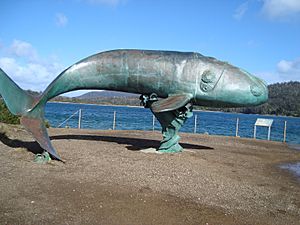
By 1750, the North Atlantic right whale was almost gone due to hunting. American whalers then moved to the South Atlantic. The southernmost Brazilian whaling station opened in 1796. Over the next 100 years, American whaling spread to the Southern and Pacific Oceans. Fleets from European countries also joined.
Southern right whales were very common in Australian and New Zealand waters before the 1800s. But they were heavily hunted from 1800 to 1850. Hunting slowly decreased as the whale population dropped. It almost stopped in coastal waters of Australia and New Zealand.
The early 1900s brought industrial whaling. The number of whales caught grew quickly. By 1937, whalers recorded catching 38,000 in the South Atlantic. They caught 39,000 in the South Pacific and 1,300 in the Indian Ocean. The actual number was likely higher because records were incomplete.
Whaling Ban and Illegal Hunts
It became clear that the whale population was almost gone. So, hunting right whales was banned in 1937. This ban worked well, but some illegal whaling continued for decades. Madeira caught its last two right whales in 1968.
Illegal whaling continued off the coast of Brazil for years. The Imbituba station processed right whales until 1973. The USSR admitted to illegally catching over 3,300 whales in the 1950s and 1960s. They had only reported catching 4.
Illegal operations continued even in the 1970s. It was also found that Japan supported these hunts. They ignored their duties to monitor whaling. Japan and the Soviet Union also agreed to keep their illegal whaling secret.
Right whales started to be seen again in Australian and New Zealand waters in the early 1960s. Some believe that if the Soviet Union's illegal hunts had not happened, the New Zealand population would be three or four times larger today.
Protecting Southern Right Whales
The southern right whale is listed as "endangered." This means it is at risk of dying out. All countries with known breeding groups protect it. These countries include Argentina, Australia, Brazil, Chile, New Zealand, South Africa, and Uruguay.
In Brazil, a special Environmental Protection Area was created in 2000. It covers about 1,560 km2 (600 sq mi) of ocean and 130 km (81 mi) of coastline. This area protects the whales' main breeding grounds in Brazil. It also helps manage whale watching.
This species is also protected by international agreements. These agreements aim to conserve whales and their homes.
Why Calves Are Dying
A project started in 2016 to find out why almost 500 young whales have washed up dead. This has happened on the Valdes Peninsula over the last ten years. Possible reasons include a lack of krill (their food) in feeding areas. Other reasons could be harmful algae or attacks by kelp gulls.
Gull Attacks
Since 1996, kelp gulls off Patagonia have been attacking live right whales. The gulls use their strong beaks to peck into the whales' skin and blubber. This leaves large open sores. These attacks mostly target mothers and their calves.
The whales spend a lot of time and energy trying to avoid the gulls. This means mothers spend less time nursing their calves. As a result, the calves are thinner and weaker.
Scientists think that waste from fish processing plants caused gull populations to grow. When less waste was available, the gulls started looking for other food sources, like whales. Scientists are worried that this behavior could spread. The IWC has asked Brazil to take action if similar gull behavior is seen in their waters. This might include removing the attacking gulls.
Whale Watching
Africa
Hermanus, South Africa, is a major center for whale watching. From June to October, southern right whales come very close to the shore. Visitors can watch them from the land or from hotels. Hermanus also has boat tours for whale watching. The town even has a "whale crier" who announces where whales have been seen.
You can also watch southern right whales at other winter breeding grounds. In False Bay, you can watch from shore or from licensed boats. Plettenberg Bay is another popular spot for whale watching. Southern right whales can also be seen off the coast of Port Elizabeth. Some make Algoa Bay their home for the winter.
Whales are sometimes seen during tours in Namibia, Mozambique, and Madagascar. Sightings along Namibian coasts have increased a lot recently.
South America
In Brazil, Imbituba in Santa Catarina is known as the National Right Whale Capital. It holds annual Right Whale Week celebrations in September. This is when mothers and calves are seen most often. The old whaling station there is now a museum.
In Argentina, Península Valdés in Patagonia has the largest breeding population. Over 2,000 whales have been identified there. The whales come within 200 m (660 ft) of the main beach in Puerto Madryn. This is a big part of the local tourism.
Uruguay made all its waters a safe haven for whales and dolphins in 2013. Dozens of whales are seen there every year during winter. Swimming with whales for commercial reasons was banned in 1985. But it was later allowed in Gulf of San Matías. This is the only place in the world where people are formally allowed to swim with this species.
Land-based watching and kayaking with whales are also popular in other locations. These include Puerto Deseado and Mar del Plata.
Even though their numbers are small, more whales are being seen off Chile and Peru. There is hope for new tourism in these areas, especially in the Strait of Magellan.
Oceania
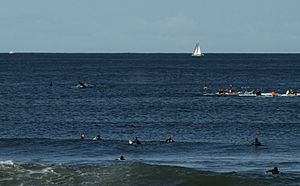
In Australia's winter and spring, southern right whales migrate along the Great Australian Bight. You can watch them from the Bunda Cliffs and Twin Rocks. The Head of the Bight has a visitor center and viewing boardwalks. Fowler's Bay offers accommodation and boat tours.
Another popular spot in South Australia is Encounter Bay. The South Australian Whale Centre helps whale watchers and tourists there. In Warrnambool, Victoria, a right whale nursery is also a popular tourist spot. The whales' travel range is growing as the species recovers. They are returning to other areas like New South Wales and Tasmania. In Tasmania, the first birth since the 1800s was recorded in 2010.
Southern right whales are also becoming more common to see from shore in New Zealand. This is especially true in southern Fiordland and along the Otago coast. On the North Island, they are seen in Northland and the Bay of Plenty. Calves have been confirmed on the main islands' coasts since 2012.
Subantarctic
In the Subantarctic Islands and near Antarctica, you can see whales on expedition tours. The Auckland Islands are a special sanctuary for right whales. Whale-watching tourism is not allowed there without permission.
Images for kids
See also
In Spanish: Ballena franca austral para niños



